|
|
|
The Great Moghuls
Being a brief guide to the dynasty that dominated India from the C15th-C18th...

 In
1221
Genghis Khan (left) erupted from the heart of Asia, forging
an Empire
reaching from China to Turkey, and stretching to the subcontinent of India.
In
1221
Genghis Khan (left) erupted from the heart of Asia, forging
an Empire
reaching from China to Turkey, and stretching to the subcontinent of India.
Born in 1336, later, Timur, or Tamberlane, as he was known in the West, a descendent of Genghis, repeated the feat, ruling his Empire from Samarkand near Uzbekistan. He penetrated India, and sacked Delhi in 1398, and returned home. This connection to Samarkand and even Delhi, was to prove an irresistible lure to the Timurids, his descendants, who all pursued the ultimate ambition: to recreate the Empire and rule it from Samarkand.
In 1483, the young ruler of
Transoxiana, Babur, earned his epithet
The Leopard, developing skills of strategy, ambition and bravery, as he defended his kingdom from its
warlike neighbours from the age of eleven. He dreamed of resurecting his ancestor Timur's Empire, but
was only able to hold Samarkand for six months in 1497. Thwarted in this direction,
Babur turned his attention south east, and took his troops into
Kashmir and the Punjab, capturing and holding Kabul in 1504, and Lahore in 1524,
on behalf of his neighbour in India, Alam Khan.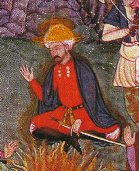
Kabul's climate suited Babur well. He was well into gardening, (if you thought his pass-time was poofy, you'd have to look him in the eye before you said so, and you'd probably end up a bit shorter if you did!). However, in 1525 he was approached by Alam Khan, Sultan of neighbouring Delhi, who lost his throne again, to his uncle Ibrahim Lodi. Babur , who had helped before, decided to make things more secure, and took Lahore for himself, and advanced on Lodi's Delhi. Babur's army was vastly outnumbered; 12,000 to Lodi's100,000 troops. On the plain of Panipat, just Northwest of Delhi, Babur drew up his 700 wagons in a circle, and waited, David Gemmel-style, for Lodi's hoard to attack. For the Leopard, despite the odds had a trick up his sleeve. He goaded the 1500 War Elephants of his enemy to attack on the morning of 21/4/1526, and unleashed his decisive weapon: gunpowder. Cannon and arquebuses put fright to the elephants, and Babur's army slaughtered their opponents. His son Humayan, presented him with the crown jewels, extracted from Agra, and Babur was Padishah of Hindustan.
Babur wasn't keen on the dusty plains of Delhi; it didn't make good gardening country. He left for Kabul, but died soon after. His philosopher son Humayan was to succeed him in 1530.
Humayan
su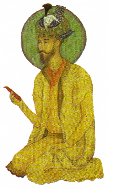 cceded
at the age of 23. Although a devout Muslim and
appreciative of gardens, he was betrayed by his officers and unable to subdue the enemies outside his
borders. A hopeful named Sher Shah was soon able to overwhelm him, and equipped
only with the fabulous wealth grabbed from Delhi, the Moghul fled to THE
superpower of the world, the Imperial Court of Persia. Ten years were spent in
exile, paying the Shah of Persia housekeeping money, and building up forces. In
the meantime, Sher Shah did those things
which Humayan and Babur had not got round to doing, namely setting up an
infrastructure, building roads, establishing taxes and other rulery sorts of
things. Humayan managed to claw back Kabul, but the prize came when Sher Shah
unexpectedly died. In 1555, Humayan waltzed back in and re-claimed his Empire.
cceded
at the age of 23. Although a devout Muslim and
appreciative of gardens, he was betrayed by his officers and unable to subdue the enemies outside his
borders. A hopeful named Sher Shah was soon able to overwhelm him, and equipped
only with the fabulous wealth grabbed from Delhi, the Moghul fled to THE
superpower of the world, the Imperial Court of Persia. Ten years were spent in
exile, paying the Shah of Persia housekeeping money, and building up forces. In
the meantime, Sher Shah did those things
which Humayan and Babur had not got round to doing, namely setting up an
infrastructure, building roads, establishing taxes and other rulery sorts of
things. Humayan managed to claw back Kabul, but the prize came when Sher Shah
unexpectedly died. In 1555, Humayan waltzed back in and re-claimed his Empire.
But it was not to last long. The Second Moghul breathed his last, when, descending a staircase and hearing the call to prayer, his zeal saw his feet entangled in his robe, and brought him crashing down. After some days concussed and paralysed, Humayan passed away, leaving the newly won Empire to his thirteen-year-old son: Akbar.
Akbar,
and his
late father's followers, strengthened
the borders and defeated enemies, giving Akbar the chance to go on to
encourage art, calligraphy, religious
tolerance, build big cities and make the Empire stable. He em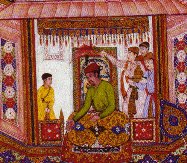 braced the need to ensure a sound
infrastructure, and worked to make his domain a strong one.
He was the first of the Moghuls to cease taxing non-muslims, and even
adopted Hindu customs. He was so interested in religion that he was forced to
take Hindu and even Christian wives, as
well as the Muslim one. He invented his own religion, comprising of
all his favourite bits from all the others. Yes, you're right; he was a bit of a
control freak, structuring the Empire
so that it was fully his. But a good Padishah has too; he made it stable,
and secure; so much so that he
felt that he could invite (forcibly) the people in Rajastan and the Deccan
to be a part of it. Akbar the Great
reigned until 27th October 1605, after
an attack of dysentery, probably not helped by the rebellion of his son Salim,
who was also feeling control freaky at the time.
braced the need to ensure a sound
infrastructure, and worked to make his domain a strong one.
He was the first of the Moghuls to cease taxing non-muslims, and even
adopted Hindu customs. He was so interested in religion that he was forced to
take Hindu and even Christian wives, as
well as the Muslim one. He invented his own religion, comprising of
all his favourite bits from all the others. Yes, you're right; he was a bit of a
control freak, structuring the Empire
so that it was fully his. But a good Padishah has too; he made it stable,
and secure; so much so that he
felt that he could invite (forcibly) the people in Rajastan and the Deccan
to be a part of it. Akbar the Great
reigned until 27th October 1605, after
an attack of dysentery, probably not helped by the rebellion of his son Salim,
who was also feeling control freaky at the time.
Thirty seven-year-old Salim
fancied the title Jahangir,
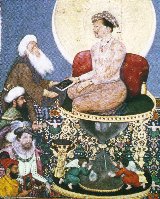 (World
seizer), which he took, as well as the Empire. Having not had to fight to
get it, he was rather into the luxurious life at court, especially the bits with
Opium and alcohol in them. The amount of time that he felt compelled to give to
these pursuits (and associated illnesses) often meant that he wasn't
always in a fit state for serious ruling, and luckily his Queen Nur Jahan was
quite keen on helping out. From 1622 she did her bit, helped out by her father
and brothers, who were quite happy to work on being Prime Minister and Generals
respectively. Meanwhile, Jahangir's sons were thinking about succession, with
the "mysterious" deaths of Khusrau and Parviz leaving only Shahryar
and Khurram in the running. On Jahangir's death in 1627, Shahryar was able to
get his hands on the treasury at
Lahore. But Khurram won the support of the army, and with the help of
father-in-law Asaf Khan, creamed the
opposition. Nur Jahan was packed off to Lahore, and Khurram took the name Shah
Jehan, and the throne.
(World
seizer), which he took, as well as the Empire. Having not had to fight to
get it, he was rather into the luxurious life at court, especially the bits with
Opium and alcohol in them. The amount of time that he felt compelled to give to
these pursuits (and associated illnesses) often meant that he wasn't
always in a fit state for serious ruling, and luckily his Queen Nur Jahan was
quite keen on helping out. From 1622 she did her bit, helped out by her father
and brothers, who were quite happy to work on being Prime Minister and Generals
respectively. Meanwhile, Jahangir's sons were thinking about succession, with
the "mysterious" deaths of Khusrau and Parviz leaving only Shahryar
and Khurram in the running. On Jahangir's death in 1627, Shahryar was able to
get his hands on the treasury at
Lahore. But Khurram won the support of the army, and with the help of
father-in-law Asaf Khan, creamed the
opposition. Nur Jahan was packed off to Lahore, and Khurram took the name Shah
Jehan, and the throne.
Sha h
Jehan
had to set-about the re-building of the Moghul coffers, ease hard-line Muslim
dissention at court by being discriminatory
against Hindus. He was also tough against Rajputs, and Portuguese expansionism,
especially when involving raids to do with forced conversion to Christianity. He
also continued Akbar's policy of persuading the independent Sultanates of the
Deccan to join the Moghul club. By 1635, Golconda fell, and the other Deccan
kingdoms were given a bit more of an incentive be unified by the presence of the
Emperor's "persuasive" son Aurangzeb. He even had an abortive crack at
Samarkand. In 1631, Shah Jahan faced grief: his Queen Mumtaz Mahal died having
their fourteenth child. On her death bed, she made him promise to build her the
greatest maus
h
Jehan
had to set-about the re-building of the Moghul coffers, ease hard-line Muslim
dissention at court by being discriminatory
against Hindus. He was also tough against Rajputs, and Portuguese expansionism,
especially when involving raids to do with forced conversion to Christianity. He
also continued Akbar's policy of persuading the independent Sultanates of the
Deccan to join the Moghul club. By 1635, Golconda fell, and the other Deccan
kingdoms were given a bit more of an incentive be unified by the presence of the
Emperor's "persuasive" son Aurangzeb. He even had an abortive crack at
Samarkand. In 1631, Shah Jahan faced grief: his Queen Mumtaz Mahal died having
their fourteenth child. On her death bed, she made him promise to build her the
greatest maus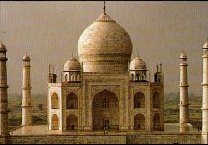 oleum
the world had ever seen. He started in 1632,
and the Taj Mahal was the result. Being rather into huge, grandiose things, such
as the Peacock throne, and the largest Mosque in India, Shah Jehan planned a
black Taj for himself across the river from his Queen's. Unfortunately for him,
he didn't get far. His illness in 1657 led his four sons to decide to get the
matter of the succession sorted. Aurangzeb was more interested in violence than
courtly life, and was able to get through his rivals. The drawback was when Shah
Jehan began to recover: after the effort he'd gone through, Aurangzeb decided
that the only thing that he could do was to imprison his father for his
remaining eight years, and get on with being Emperor.
oleum
the world had ever seen. He started in 1632,
and the Taj Mahal was the result. Being rather into huge, grandiose things, such
as the Peacock throne, and the largest Mosque in India, Shah Jehan planned a
black Taj for himself across the river from his Queen's. Unfortunately for him,
he didn't get far. His illness in 1657 led his four sons to decide to get the
matter of the succession sorted. Aurangzeb was more interested in violence than
courtly life, and was able to get through his rivals. The drawback was when Shah
Jehan began to recover: after the effort he'd gone through, Aurangzeb decided
that the only thing that he could do was to imprison his father for his
remaining eight years, and get on with being Emperor.
Aurangzeb
kept Shah Jehan shut in the Red Fort in Agra, with little comforts apart from a
bit of palace, a  view
of the Taj, and the whole of his Harem and musicians. Aurangzeb got on with his
conquest of southern India, which he
wanted to make a hard-line Muslim state. Over the years, this was his chief
preoccupation. Fierce Hindu resistance from guerilla-warriors like Shivaji and
Shambhaji slowly drained the Imperial cash bags, so that on his death in 1707,
the ninety-year-old Padishah left an inheritance that was hard to defend, and
with little funds to support such action.
view
of the Taj, and the whole of his Harem and musicians. Aurangzeb got on with his
conquest of southern India, which he
wanted to make a hard-line Muslim state. Over the years, this was his chief
preoccupation. Fierce Hindu resistance from guerilla-warriors like Shivaji and
Shambhaji slowly drained the Imperial cash bags, so that on his death in 1707,
the ninety-year-old Padishah left an inheritance that was hard to defend, and
with little funds to support such action.
The following Moghuls saw their power fade, as the British built their presence in the subcontinent, eventually ruling in the name of the Great Mughul in Delhi, whose power was, in reality, restricted to the confines of the Red Fort. Badahur Shah II helped incite the Sepoy mutiny, and Moghul power finally ended with his exile in 1857 to Rangoon. He died in 1862.
![]()
None yet, but keep checking, and I'm sure that some will appear!